eCommerce metrics let you track business performance, including website traffic, average order value, and more.
It’s even easier to track them than to analyze offline marketing success. Digital marketing and analytics tools automatically count how many people view your ad, subscribe to the email newsletter, or leave the website without converting. Your task is to focus on the most needed numbers and enhance them.
This post will present five crucial website metrics with actionable tips to improve them.
5 Most Essential eCommerce Metrics To Track & How To Improve Them
Let’s dwell on conversion rate, click-through rate, average order value, customer lifetime value, and shopping cart abandonment rate.
1. Conversion Rate
The conversion rate indicates how many people fulfill the desired action. To calculate it, you need to divide the number of converted visitors by the total number of viewers and multiply it by 100.
Conversion rate = Conversions / Total number of visitors * 100
What can be considered conversion in eCommerce? These actions include leaving an email address, purchasing, or enrolling in the loyalty program. The important action here is the number of sales. Optimize your conversion rates to see more revenue from the same number of visitors.
How to improve Conversion Rate
What makes the business stand out with so much competition around the corner? The decisive factor in converting is the flawless user experience from the home page to checkout and beyond. From that point of view, increasing conversion rates involves the steps, such as:
- adding crucial elements of eCommerce checkout UX;
- ensuring simple navigation;
- configuring intelligent on-site search (AddSearch shows that site search results in 1.8 times more conversions, with 30% of visitors using the site search box);
- writing detailed product descriptions with images in high resolution;
- placing calls to action;
- offering personalized experience;
- creating time-sensitive discount codes and deals;
- speeding up the website;
- making the store mobile-friendly.
Here is how the COS online store encourages its visitors to buy. We see a discount proposition for subscribing: “15% off your first full-price order when you subscribe”. The navigation is smooth, and you can observe the advanced search feature with auto-suggestion and error comprehension.
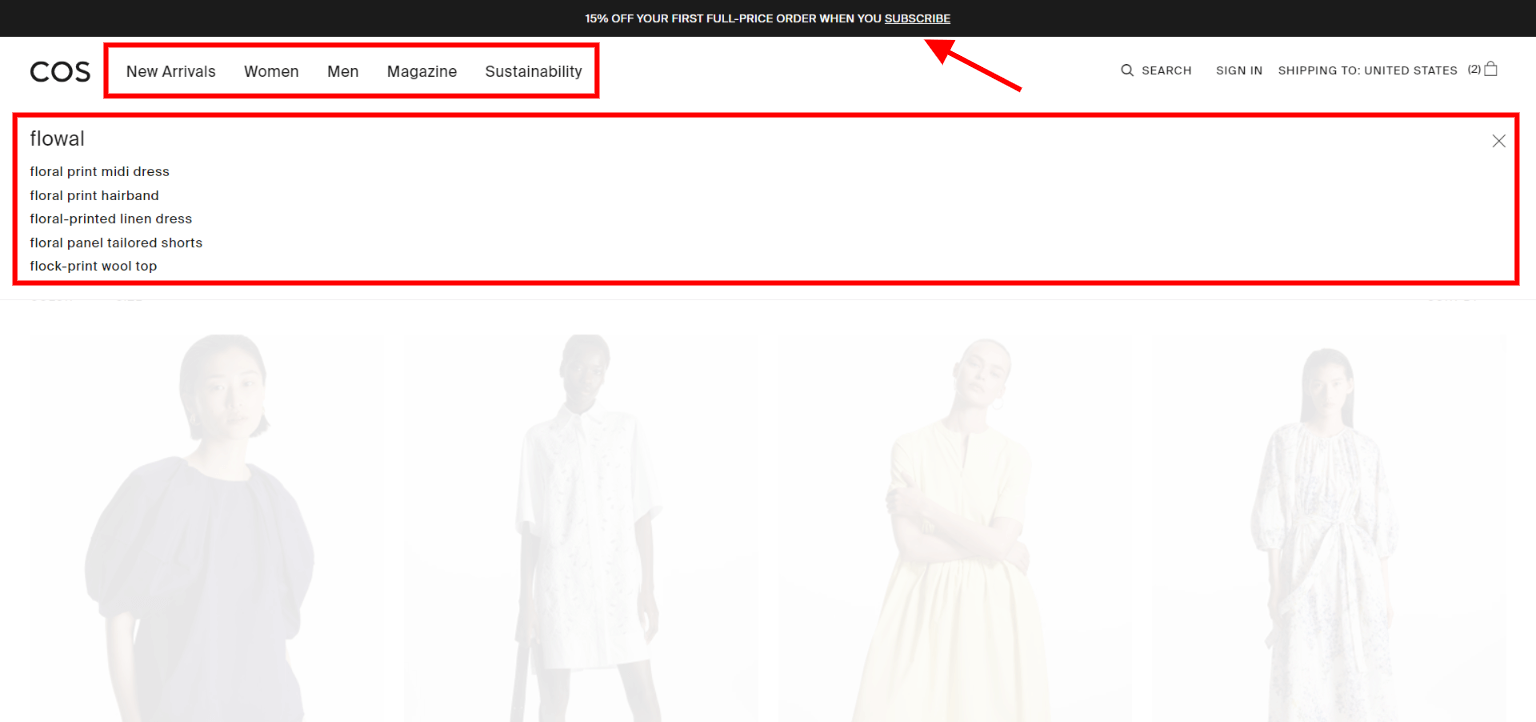
2. Click-Through Rate
The click-through rate is the percentage of clicks a PPC ad gets compared to total impressions. It illustrates whether your ad is relevant to the user request in search. So the higher this metric is, the more people click on your ad and go to the store. And the chances are that they will convert.
How do you calculate the CTR? The formula is:
CTR = Total ad clicks / Impressions for the ad * 100
You may check the click-through rate via your PPC account dashboard. Below is the Google Ads profile. The tool provides statistics on the ads with the number of clicks, conversions, impressions, and CTR.

How to improve Click-Through Rate
Before increasing the CTR, you need to understand that a high CTR may be an ambiguous metric to be proud of. For example, you can write anything catchy to attract visitors. But will it result in conversions? Draft your ad copy to be relevant and profitable because you pay for every click the ad gets.
Strategies to improve CTR include:
- writing an ad copy with long-tail keywords to match the request;
- targeting the right demographic and geo;
- using Ad Extensions (additional information, seller’s rating, phone number, site links);
- creating captivating headlines, CTAs, and unique value propositions.
Let’s analyze three ad examples below. We can see that the first brand shows a rich ad with extensions, an image, and a comprehensive description of its proposition. These tricks will surely direct more visitors to the store. Who will refuse a one-of-a-kind arrangement from professional florists? I won’t!
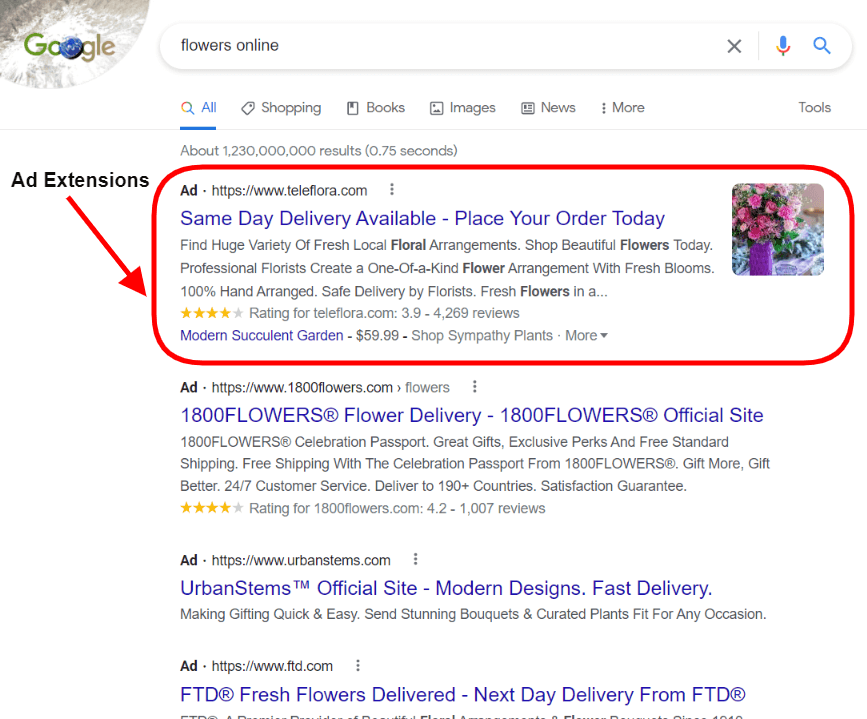
3. Average Order Value
This metric demonstrates how much people spend per order on average.
The calculation formula is the following:
AOV = Total Revenue / Number of orders
If you earn $10,000 a month and have 20 orders for that same period, the AOV will be $500. Average order value shows the customers’ shopping behavior and whether they’re ready to leave more money in the store. Improving this metric is one of the most cost-effective decisions.
Why? Because you directly impact the revenue by incentivizing clients to purchase more goods in one order. You can evaluate what strategies bring such changes and introduce them regularly or ditch the ineffective ones if the AOV remains the same or decreases.
How to improve Average Order Value
Reasons to add more products should bring value to customers. What can such value be? It’s a bargain or profit, e.g.:
- personalized sections according to shoppers’ preferences;
- free shipping if customers reach a specified threshold (set the reasonable amount);
- selling product bundles at a more attractive price than buying them separately;
- upselling/cross-selling related items or the same ones at a higher price;
- discounts on the next order if the current one exceeds a certain amount.
Below is how Zalando boosts its sales with the help of the free shipping threshold and “Better together” section.
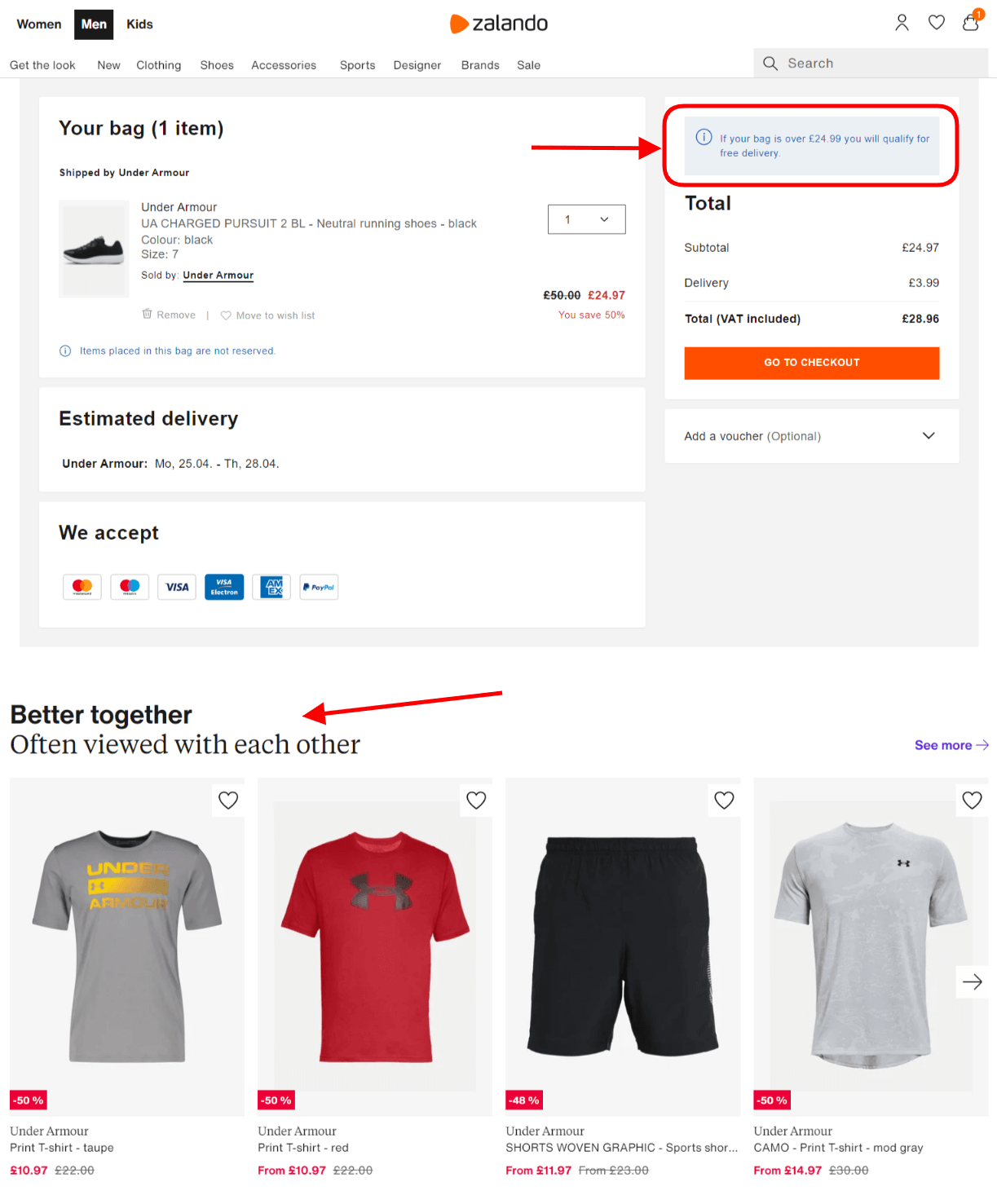
4. Customer Lifetime Value
How successfully does the store attract repeat purchasers? Look at your customer lifetime value. It’s the expected revenue the store gets from a customer through the course of the relationship. This metric revolves around communication with clients and building loyalty.
The formula embraces several accompanying eCommerce marketing metrics and looks like this:
CLV = Average Order Value * Average Number of Transactions * Retention Period
Suppose you have a client spending $100 on one order each month. They stay your customers for two years. CLV will be $100 * 12 (12 orders per year) * 2 = $2400. This total includes the money you spend on acquisition and retention. So by knowing this parameter, you can estimate whether you need a better customer retention strategy as it’s easier to convert an existing client than a stranger.
How to improve Customer Lifetime Value
As the CLV has AOV in its formula, the techniques above will also help you increase customer lifetime value. How do you magnetize clients to the store? Loyalty stems from a quality customer experience and assistance, as follows:
- creating onboarding programs to make the first impression;
- launching loyalty programs with points. Customers can earn them by doing specified things and receive discounts on the following orders;
- quickly resolving customer complaints (artificial intelligence working 24/7 may come as a cost-effective solution);
- email marketing to re-engage customers and drive them back to the store;
- retargeting campaigns to display ads on third parties.
A loyalty program can motivate consumers to spend a certain amount and receive exclusive discounts, early access to products, and other incentives. Maude store offers three layers of loyalty and bonuses for each of them. But tiered programs are just one type among many. Take the time to compare the different types of loyalty programs to find out which one suits your brand best.
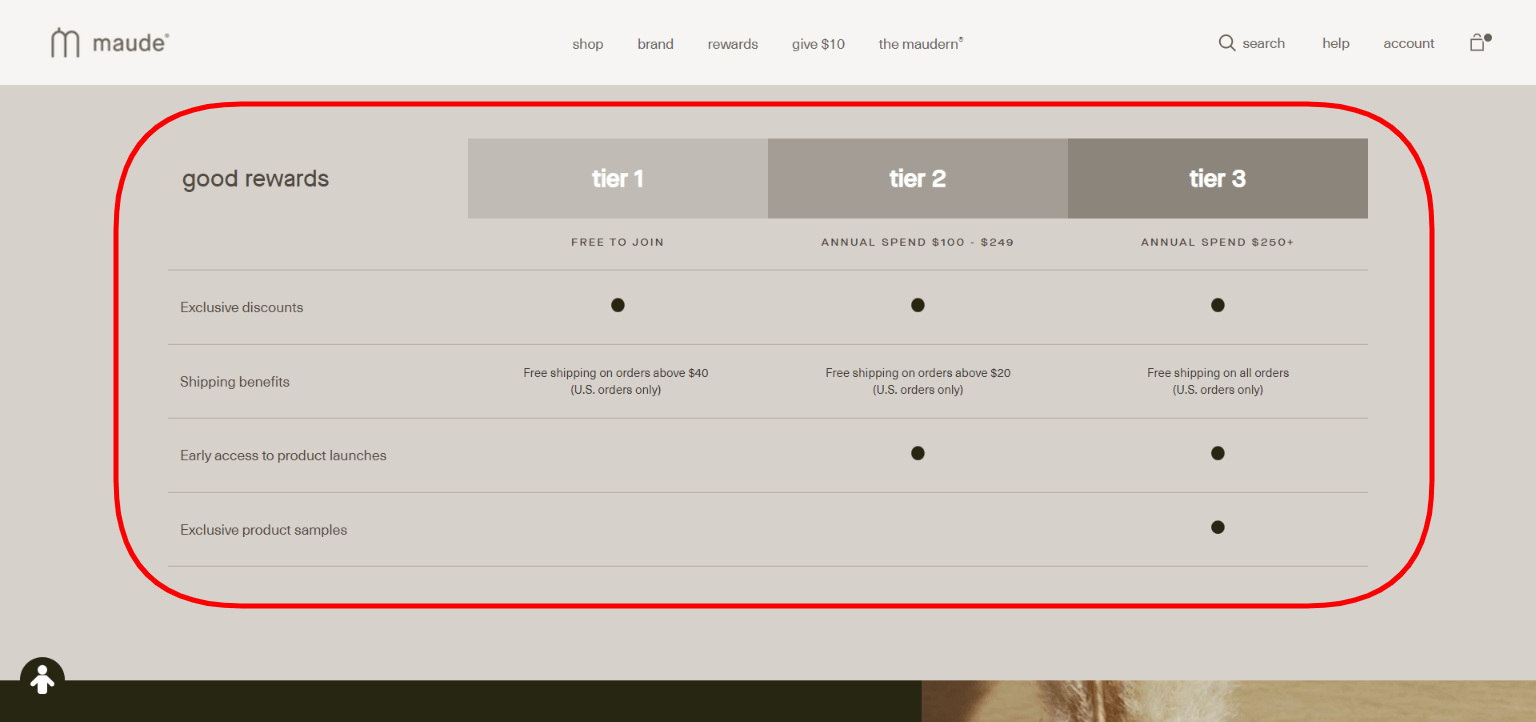
5. Shopping Cart Abandonment Rate
Cart abandonment happens when prospects close the website after adding products to the cart. Why do they ditch the website even if they find the needed goods? There are several possible reasons, from mere window-shopping to serious issues with your interface.
Here’s the deal: analyze whether the cart abandonment happens before checkout. If yes, you can create a wish list. Shoppers will move their products to this list without affecting your cart abandonment rate. If they refuse to complete the checkout, revise how easy it is to finish the order.
How to improve Shopping Cart Abandonment Rate
Bring shopping cart abandonment down by following the steps below:
- stating shipping costs as early as possible;
- simplifying the checkout process. Limit the number of required fields. Some information isn’t so crucial for the order. Allow customers to check out as a guest or sign in with social media instead of creating an account;
- targeted emails and push notifications;
- retargeting buyers on other websites and apps.
Pay attention to the screenshot from Paula’s Choice newsletter. It reminds a prospect of the items in the cart and suggests 20% off the next purchase to spur the existing and subsequent orders.
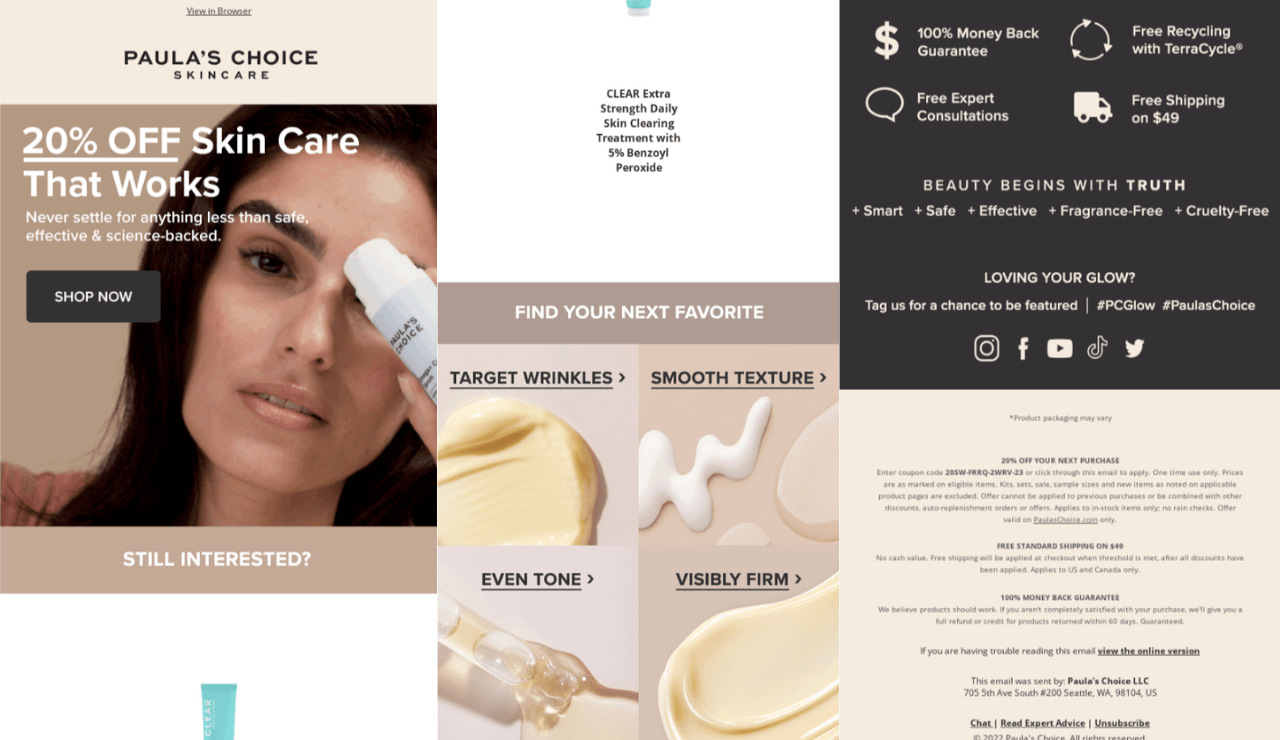
Conclusion
We’ve discussed five crucial eCommerce metrics to track:
- conversion rate;
- click-through rate;
- average order value;
- customer lifetime value;
- shopping cart abandonment rate.
These aren’t the only metrics you can track on the website. But they deserve paying attention. You might be wondering: why do we need metrics at all? They help your store like gauges on the ship. Knowing the direction of the wind, the speed, and the condition of the vessel (your store), you will confidently stand at the helm.
Thus, we talk about profit and the business future. The eCommerce metrics help you determine which parts suffer or bring your profit. So start with these parameters and employ the tips to improve them.
Not sure where to start with tracking and improving your eCommerce site’s performance? Contact ReVerb! We’ll help you generate a winning eCommerce marketing strategy that will skyrocket your sales.
Author Bio

Kate Parish, chief marketing officer at Onilab, with 8+ years in Digital Marketing and eCommerce web development promotion. Kate constantly upgrades her knowledge and skillset to stay fit in the progressing online world. She always does exhaustive research in such spheres as SEO, branding, SMM, PPC, and Magento PWA development, before sharing her expertise with a wide audience.











